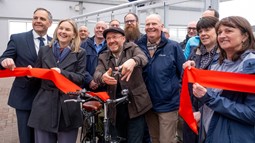Sustrans has collaborated with major architecture bodies to officially recognise the importance of stakeholder engagement to those working in the built environment sector. In this blog, our Principal Designer for Scotland, Paul Ruffles, explains the development and what it means for Sustrans.

Meaningful public engagement is vital in helping Sustrans deliver projects that connect communities and make it easier for people to walk, wheel and cycle. Credit: Gary Baker Photography
In partnership with the Royal Institute of British Architects (RIBA), Association of Collaborative Design (ACD) and numerous other partners and contributors, Sustrans has confirmed the addition of the ‘Engagement Overlay’ to the RIBA Plan of Work widely used by professionals working in the sector.
What is the RIBA Plan of Work?
RIBA’s Plan of Work is the definitive model for the design and construction process of buildings in the UK.
The plan provides people working on all stages of a construction project a structured way of organising design and construction processes into defined stages.
For each stage the Plan of Work provides details on the key activities to be completed within that stage and deliverable outcomes.
What is the Engagement Overlay?
Overlays provide an additional layer of information on specific topics that have been mapped to the Plan of Work.
Through significant input from myself and Places for Everyone Engagement Manager Rachel Goater, Sustrans worked with RIBA to develop an overlay for the Plan of Work, which focuses on public engagement.
The Engagement Overlay, as agreed by RIBA, ACD and Sustrans, and endorsed by Landscape Institute, is a resource to increase understanding and highlight the importance of the engagement process throughout all work stages.
The guide will help to:
- facilitate a more democratic design approach
- share decision-making
- provide a central benchmark and reference point for best practice
- build capability within architects and built environment professionals
- ensure the project and process meets the needs and aspirations of people and communities
- be a resource for facilitating client and community communications.

Sustrans Scotland's Co-Design team and project partners discuss ideas with stakeholders in Wick. Credit: Sustrans Scotland
Why is this happening now?
The adoption of the Engagement Overlay addresses the crucial need for embedded engagement within current frameworks, aligning with national policy and filling a skills gap among professionals.
There is a growing recognition amongst people working in the sector of the value that direct engagement with the public and stakeholders can bring to the design and construction of projects.
Projects with integrated, high-quality engagement consistently demonstrate more positive outcomes for people and communities.
These range from:
- an increased sense of empowerment amongst those who took part
- evidence of the project better responding to local needs and aspirations
- greater support for projects at key stages where formal consultation processes are required.
One challenge has been how to identify a consistent approach to engagement and making that understandable to people who use the RIBA Plan of Work.
The Engagement Overlay provides a simple way for professionals to plan for and integrate engagement into design and construction programmes that use the RIBA Plan of Work.
The Overlay is presented in eight stages, like the RIBA Plan of Work, with similar terminology to provide familiarity and ease of use.
At each stage of the Engagement Overlay a simple list of engagement related activities (Core Tasks) and list of deliverables or Stage Outcomes that would normally be produced for each stage are presented.

Colleagues from Sustrans' Street Design team explain town centre interventions with the use of a model design kit. Credit: Gary Baker Photography
How was it agreed?
To ensure the robustness of the Engagement Overlay, RIBA, ACD and Sustrans conducted peer reviews and trials and engaged with 25 delivery partners and individuals across the UK.
This ensured that that the Core Tasks and Stage Outcomes within the overlay are understandable and represent best practice in engagement.
What does this mean for Sustrans?
Meaningful public engagement is vital in helping Sustrans deliver projects that connect communities and make it easier for people to walk, wheel and cycle.
We are therefore thrilled to have worked in partnership with RIBA, ACD and other contributors to ensure the adoption of the Engagement Overlay to the RIBA Plan of Work.
The Engagement Overlay aims not only to amend a procedural gap but also to help communities create resilient and adaptive environments to climate change and biodiversity crises.
By embracing this participatory approach, Sustrans and its partners envision a future where built environments are co-designed with the people they serve, fostering strong social values and environmental resilience.





